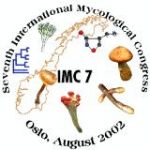International Commission on the Taxonomy of Fungi

General Meeting
International Mycological Congress, Oslo, Norway, 14 August 2002
Attendees
Regular members:
Keith Seifert (acting chair)
David Hawksworth (past chair)
Paul Cannon
Pedro Crous
David Hibbett
Peter Johnston
Gen Okada
Amy Rossman
Mike Wingfield
Ex-officio members:
Christian Kubicek (Chair, International Subcommission on Trichoderma).
Rob Samson (Chair, International Commission on Penicillium and Aspergillus (ICPA)).
Minutes
The meeting started at 2:07 PM.
The membership was discussed and the newly proposed members were voted into office.
David Hawksworth presented a brief history of the ICTF and some of the past accomplishments. The International Commission on Penicillium and Aspergillus has been the most active subcommission over the past eight years and has organized several successful workshops using seed funds from the International Union of Microbiological Societies (IUMS). The workshops have resulted in several publications that have helped to unify the field. In addition, the International Code of Biological Nomenclature was circulated but is now considered moribund.
Keith Seifert mentioned that a conference symposium was organized by ICTF at the Jerusalem IMC6, but because of the many cancellations at that congress, it is unclear how successful that symposium had been. He also noted that during his previous tenure with ICTF, Paul Cannon had written a series of three articles on name changes in fungi of economic importance (e.g. Microbiological Sciences 3: 168-171, 1986 and Mycopathologia 111: 75‑83, 1990).
Rob Samson discussed the relationship of IUMS and International Mycological Association (IMA). Rob is currently the Chair of the Division of Mycology for the IUMS under which the ICTF is considered a COMCOF. Thus, the ICTF is affiliated with both major mycological organizations. The ICTF is required to provide an annual report to IUMS, but currently has no reporting responsibility to the IMA. Keith Seifert promised to contact the new president of the IMA to introduce the commission, and to attempt to strengthen this relationship. He described several of the COMCOFs of the IUMS Mycology Division, which included ICPA, the International Commission on Food Mycology, the International Commission on Yeasts, and the International Commission on Education in Mycology. The total IUMS budget is rather small, but there is now a possibility for ICTF to apply for seed money from the Mycology Division or the IUMS to organize sessions or symposia.
The purpose of the ICTF was discussed as stated in the statutes and was suggested to include promoting good taxonomic practices such as depositing voucher strains. The need for better communication was recognized. It was suggested that articles be written for the newsletters of the major mycological societies and that a Web site be established through both the IUMS and the IMA. In addition it was suggested that the ICTF increases the groups of fungi represented because the group has an ascomycete orientation at present, that the geographic representation be broadened, and that more molecular representation would be useful.
The current statutes of the ICTF were reviewed and the following changes were proposed:
- Under #3, it was suggested that the membership should be allowed to exceed 10 persons.
- Under #2 & #8, it was suggested that the two articles should be united.
- Under #5, it was suggested that a Past Chair position be created. This passed unanimously. In addition it was proposed that following the phrase “arrange a ballot” be added “via email” and that “within four calendar months” be deleted and replaced with “within thirty days via email”. This passed unanimously.
In discussing activities for the ICTF, Rob Samson suggested that there is a need for training workshops in systematics research. The group came up with such ideas as a workshop on molecular phylogeny that would include basic training in molecular systematics; a workshop on botanical nomenclature including such topics as the International Code of Botanical Nomenclature, higher taxon classification and anamorph-teleomorph classification; and a workshop on handling fungi. These workshops could result in handbooks with protocols that are useful to non-mycologists who work with fungi. The IUMS will be meeting in San Francisco in 2005 while the next IMA meeting is in 2006 in Cairns, Australia. Workshops could be organized for those meetings as well as stand-alone workshops, with the possibility of presenting workshops at non-mycological meetings.
The Subcommissions on specific groups of fungi were discussed. The ICPA was very successful as mentioned above. The other subcommissions such as the one on Fusarium have held sessions and workshops at various meetings as well as developing a database of Fusarium names. The subcommission on Trichoderma was active for a while, especially in developing collaborative research studies. Additional subcommissions were proposed including one on Diaporthe-Phomopsis (Rossman), Mycosphaerella and its anamorphs (Cercospora, Cladosporium, Septoria, etc.) (Crous & Okada), and Colletotrichum (Cannon). The possibility of stimulating the formation of a subcommission on Cryptococcus was mentioned, and well as possible interaction with the Rhizoctonia-subject matter committee of the International Society of Plant Pathology (http://plymouth.ces.state.nc.us/irc/). Some of the potential activities of the subcommissions include coordination of the use of cultures in research and validation of the identification of cultures in culture collections.
Keith Seifert was elected Chair of the ICTF and Gen Okada was elected Secretary.
The Website is: www.iums.org under mycology, COMCOFS.
The meeting was adjourned at 3:55 PM.
Minutes taken by Amy Rossman, edited by Keith Seifert and Gen Okada.